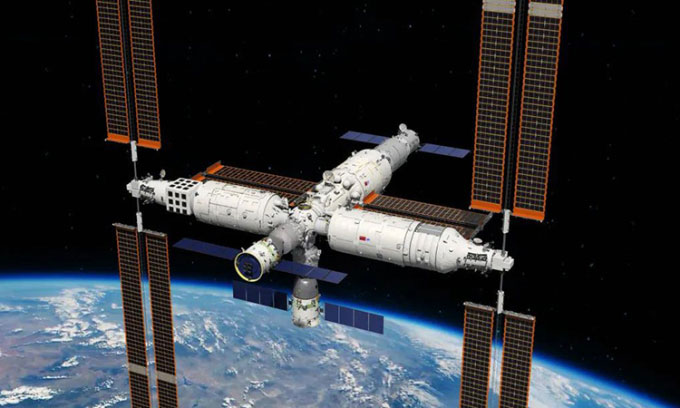The structure of the Chinese space station after completion
With the success of the launch of the Shenzhou 14 manned spacecraft on June 5, China is rapidly moving towards building the Tiangong space station into a national space laboratory, CGTN reported on June 12.
From the core module Thien Hoa orbiting the Earth, the space station will expand into a 3-module T-shaped structure with Thien Hoa in the center and two laboratory modules, Wentian and Mong Thien, on either side.
Van Thien is expected to launch in July and Mong Thien in October. When these two modules come into operation, the space station will have a total living space of more than 110m3 with 6 bedrooms, 2 bathrooms, enough space for 6 astronauts. A total of 25 science cabinets will be installed in 3 modules. Each cabinet is like a mini laboratory that can support the conduct of experiments.
Thien Cung station is expected to operate in low Earth orbit with an altitude of about 340 - 450km above the Earth's surface. The design life of this structure is 10 years, but experts believe it can last more than 15 years with proper maintenance.

Simulation of the basic three-module structure of the Chinese space station.
Thien Hoa core module
Thien Hoa core module was launched into orbit in April 2021, is the command and management center of the space station. It provides the propulsion to maintain the station's orbit, while also controlling the working conditions inside. With a length of 16.6 m, a maximum diameter of 4.2 m and a launch weight of 22.5 tons, it is the largest spacecraft China has ever developed.
Thien Hoa has a living space of about 50 m3, which is the main living space for astronauts. They can also conduct science experiments here. A total of six Chinese astronauts on two separate missions lived and worked on this module, then returned safely to Earth.
The three Shenzhou 12 crew members were the first to arrive at Tianhe, working from June to September last year. The Shenzhou 13 crew flew to the core module in October 2021 and returned to Earth in April 2022, setting a new record for China's space flight time - 182 days.
Thien Hoa is equipped with two berths to link with two laboratory modules and three docking berths for cargo, passenger or other spacecraft. The core module also has an exit for astronauts to conduct space activities.
Module of Wentian laboratory
The two lab modules are similar to the core module in terms of dimensions and weight, although China has not revealed many more details.
Wentian is mainly devoted to the study of cosmic life sciences. It is equipped with laboratory cabinets that can support life, ecology, and biotechnology experiments, as well as comparative studies on biological growth mechanisms under various gravitational conditions.
In addition, the laboratory cabinet can be used to study the growth, development, genetics and aging of plants, animals and microorganisms in space, as well as to study closed ecosystems.
The science instruments in the module also allow for multilevel biological experiments on molecules, cells, tissues and organs with a variety of probe methods, for example by visible light, fluorescence and imaging micrograph.
Module lab Mong Thien
The Mong Thien laboratory module mainly serves microgravity scientific research. This module equips laboratory cabinets for many fields such as fluid physics, materials science, combustion science, basic physics and aerospace technology.
The world's first space-based cold atomic clock, consisting of a hydrogen clock, a rubidium clock and an optical clock, will be installed on Mong Thien. They are expected to form a time and frequency system with the highest accuracy and frequency stability in space, for scientific research such as gravitational redshift or sophisticated structural constant measurement. .
When the International Space Station (ISS) is decommissioned in the next few years, Thien Cung may become the only station still operating. The China National Space Administration (CNSA) has expressed its willingness to cooperate internationally and to allow non-Chinese astronauts to participate in future station missions.
- China intends to operate the new space station in 2022
- Chinese space station caught fire in the South Atlantic sky
- China plans to launch Tiangong Space Station similar to ISS by 2020
- The Chinese space station can fall freely to Earth
- In 2019 the Chinese space station will fall to Earth
- The object caught fire, fearing the Chinese space station to fall
- Overview of China's Thien Cung 1 Space Station
- The second Chinese space station may be about to fall to Earth
- The stray 8.5-ton space station will create
- The Chinese space station will fall to Earth in the next 24 hours
- The reason why China's 8.5-ton space station doesn't burn out when it falls
- Out of control, the 8.5-ton Thien Cung 1 space station was about to fall to Earth
 Norway built the world's tallest wooden tower
Norway built the world's tallest wooden tower Kremlin
Kremlin Ashurbanipal: The oldest royal library in the world
Ashurbanipal: The oldest royal library in the world Decoding the thousand-year construction of Qin Shihuang shocked the world
Decoding the thousand-year construction of Qin Shihuang shocked the world